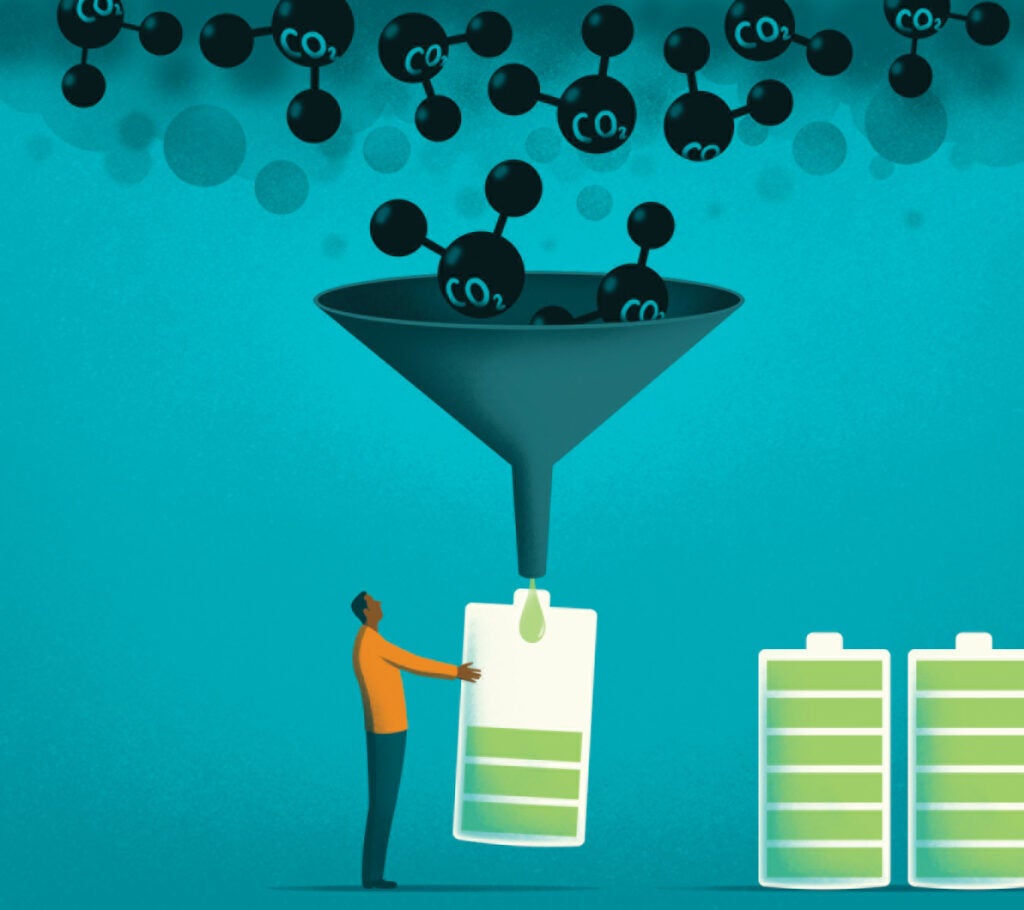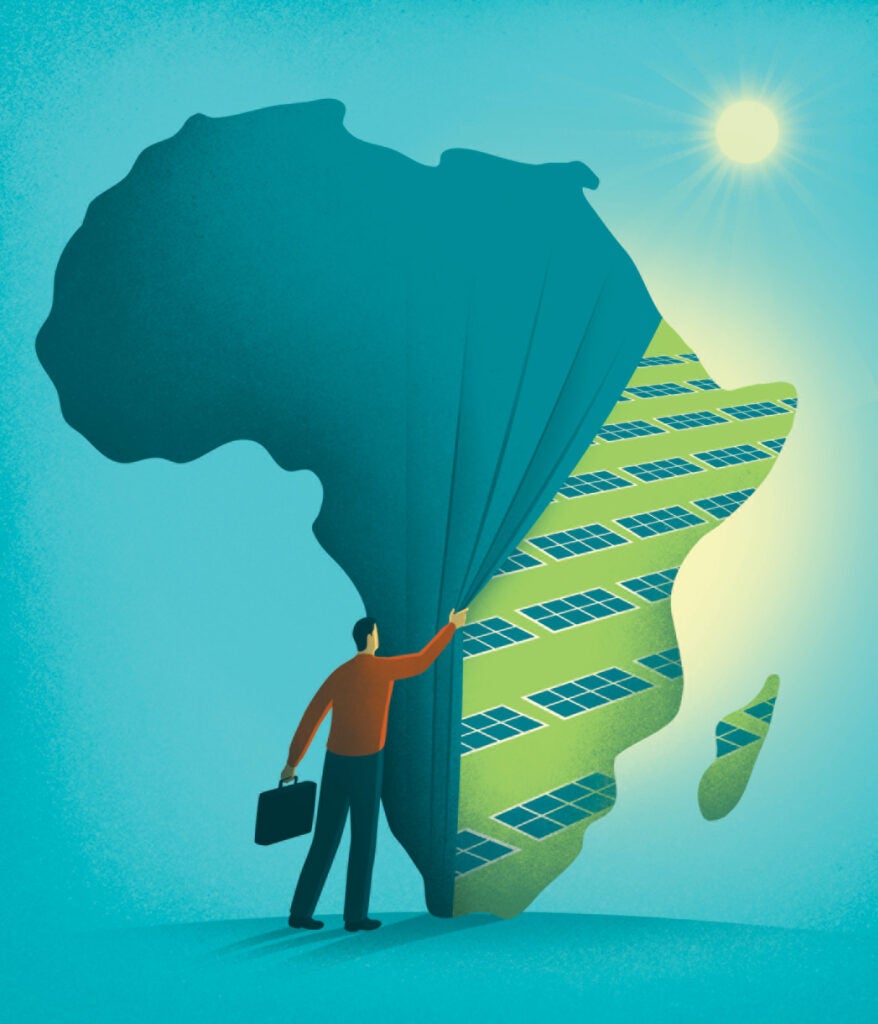Power Players: How McDonough Alumni Are Electrifying the Energy Revolution
Mujinga Mwamufiya (MBA’04) got her start in the energy sector in the late ’90s, transitioning over the years from oil refineries with Sunoco to her current role as vice president of strategic projects at Electric Hydrogen, a green hydrogen tech company.
Her journey reflects a global trend. Over the past decade, renewable energy consumption has surged by more than 12%, with a 15% increase from 2020 to 2021 alone. The International Energy Association (IEA) predicts that by 2028, renewable energy sources will account for over 42% of global electricity generation.
Mwamufiya credits her shift to happenstance. At the time, she was working for AES and traveling a lot, a schedule unsustainable with children. She needed a local job and found opportunities in California’s renewable sector. “It just made sense,” she says. “As the market pivoted toward renewables, it felt right in terms of potential and my interests. Now, I feel grateful that I can tell my children I’m creating green energy rather than digging dinosaurs out of the ground.”
Here, we highlight how Mwamufiya and three other Georgetown business alumni are fueling clean energy.
Accelerating Green Hydrogen
Dubbed the holy grail of decarbonization, green hydrogen is made by using renewable energy to split water into hydrogen and oxygen. The resulting molecule produces little to no carbon emissions.
The biggest challenge has been whether it is possible to produce green hydrogen at a low enough cost to replace — or significantly reduce — our dependence on oil and gas. Enter Electric Hydrogen. Last year, the startup co-founded by Derek Warnick (B’07) became the first in the green hydrogen industry to reach unicorn status. The company’s promising electrolyzer, which is capable of producing hydrogen much more efficiently and at lower cost than their competitors, has led to investments from the likes of Microsoft, Amazon, and BP.
“We manufacture the world’s most powerful, efficient, and low-cost hydrogen electrolyzer,” says Warnick, who serves as the company’s chief financial officer.
The company operates two plants in California — a 1 MW electrolyzer plant in San Carlos and a 10 MW electrolyzer plant in San Jose. The latter can produce nearly five tons of green hydrogen per day, or the equivalent of 1.8 million gallons of gasoline annually. Electric Hydrogen recently opened a 187,000-square-foot factory in Devens, Massachusetts, where they manufacture and test their electrolyzer stacks in-house. And they are in the process of building a 100 MW plant in Texas, which will be the largest plant of its kind in the United States.
By manufacturing the stacks in-house and assembling the complete electrolysis system, Electric Hydrogen boosts efficiency and drives down the cost of production. But what does all this mean for consumers and businesses?
“It means we can produce more hydrogen with the same scale of equipment,” says Mwamufiya. “Electric Hydrogen helps optimize production because our product is more efficient than the rest of the market. Our electrolyzers produce more hydrogen per unit of power than anybody else, translating efficiency into dollars — and we do it with a more compact footprint.”
Mwamufiya means the literal footprint. Green hydrogen can play a key role in the production of renewable fuels, which can easily integrate into industrial plants. In doing so, Electric Hydrogen displaces “gray hydrogen” in the supply chain to produce greener fuels that power transportation vehicles, from trucking to airplanes and shipping vessels. The latter two, which are not well suited to electricity or the lithium-ion batteries required for wind and solar power, accounted for 4% of the total global energy-related CO2 emissions in 2022, according to the IEA. And both industries have been charged with significantly reducing their emissions.
Last year, United Airlines invested in Electric Hydrogen, with the company’s CFO Michael Leskinen praising the company for being “further along than just anything else I’ve invested in.” Electric Hydrogen’s technology also is being used to serve demand from OCI Global, a producer and distributor of nitrogen, methanol, and hydrogen products and solutions, to produce green methanol for shipping.
“The energy density of a gallon of gasoline is really, really tough to beat,” says Warnick. “Green hydrogen allows us to build upon a lot of gasoline’s positive attributes without the negative environmental ones. In the case of aircraft, for example, we’re working toward sustainable aviation fuel that offers zero net carbon emissions without changing the technology of the airplanes themselves.”
Leveraging CO2
In the shadow of Denali sits two coal power plants that provide a small fraction of the electricity used across Alaska’s Railbelt region — but emit the highest CO2 emission per kilowatt-hour. Known as Healy 1 and 2 for the town in which they reside, the plants contribute to Alaska’s status as the fourth largest producer of carbon emissions per capita. However, they also produce cheap, reliable energy for the nearly 100,000 residents served by Golden Valley Electric Association (GVEA).
Therein lies one of the biggest conundrums for renewable energy in an area where residents already pay 2.3 times the national average for energy — and where electricity can mean the difference between life and death during the harsh, dark winters.
Echogen Power Systems, led by CEO and co-founder Phil Brennan (MBA’94), hopes to change that. They have partnered with Westinghouse Electric Company and GVEA to replace the coal plants with wind turbines and the long duration energy storage technology developed by Echogen.
“The big problem with solar and wind is the sun doesn’t always shine and the wind doesn’t always blow, and humanity’s demand for electricity occurs all day, every day,” says Brennan. “Up until this point, energy storage has primarily relied on the same lithium-ion battery that’s in your Tesla or your cell phone. But the qualities and characteristics of lithium-ion do not support the longer durations required to make wind and solar capable of providing all of the planet’s electricity needs.”
According to the Department of Energy, the average duration of utility-scale lithium-ion batteries is 1.7 hours, reaching up to four hours. Echogen’s solution provides 24 hours of storage and is building a 50-megawatt system that uses supercritical CO2 to store the energy. According to Brennan, that solution can store enough to power 225,000 to 300,000 average U.S. households for a year. “Supercritical CO2 is our secret sauce,” says Brennan. “It’s a magical fluid.”
Here’s how it works. Wind and solar generate electricity and often in amounts greater than what the electricity grid can consume. When that is the case, the excess electricity is converted into heat using supercritical CO2, a fluid that has the density of a liquid but moves like a gas and requires considerably less energy to compress. That in turn is used to heat up another medium — in this case, concrete — which stores the energy as heat to be later converted back into electricity when the renewable sources are unable to produce enough electricity.

Replacing a dirty but reliable coal plant with a combination of wind and Echogen’s energy storage system is often considered a gamble by the notoriously conservative power producers, Brennan admits. But the vision of GVEA to produce renewable electricity at a level that makes it one of the most “renewable” of all U.S. utilities is one with high reward.
“It’s not a CO2 sequestration play, where we’re sucking CO2 out of the atmosphere and burying it in the ground,” he says. “This is CO2 that’s already been used, and we’re just putting it to better use.”
Healy 1 and 2 are far from Echogen’s only project. Brennan started the company 17 years ago after meeting a serial inventor, Michael Gurin, in Chicago. They had the idea to “recycle lost industrial energy that would normally go up the stack.” Initially, they focused on the manufacturing sector, which contributes nearly a quarter of the world’s CO2 emissions, according to the IEA. Today, in addition to the project in Alaska, they’re working on solutions for both renewable and non-renewable energy, including nuclear and solar photovoltaics, concentrating solar thermal power and building a prototype high-temperature industrial heat pump that converts green electricity into usable steam that was previously generated by burning natural gas.
“I credit my Jesuit education at Georgetown, which reminds us of our stewardship responsibilities and gave me the foundation to address the big challenges like climate change that don’t have easy, obvious solutions,” Brennan says.
Expanding Markets
Africa presents a unique energy paradox. Despite being the richest continent for renewable energy resources, it is also the most energy deficient. According to the IEA, Africa holds 60% of the world’s solar resources, yet only 1% of the population relies on solar energy, and as of 2022, 43% of the population lacks access to any kind of electricity.
Of course, these numbers vary from country to country. In Kenya, for instance, 75% of the population has access to electricity and at least 90% of the country’s power comes from renewable sources, making it an emerging leader in the global energy landscape.
Based in Kenya, GridX Africa is working to build upon the nation’s success — and helping to power business growth across sub-Saharan Africa. With projects in Kenya, Tanzania, Mozambique, and the Congo, they develop commercial-scale solar installations and provide financing for clean energy projects.

“We work on everything from safari lodges to shopping malls, cement plants, and petrol stations,” says CEO Ryan Dunn (MBA’20). “Using a zero-upfront, CapEx model, we develop bespoke renewable energy solutions and provide long-term financing solutions.”
When the company started seven years ago, the biggest challenge was overcoming skepticism around solar energy. That’s abated over time, allowing Dunn and his team to address another lingering issue: how to determine credit worthiness in countries without third-party credit bureaus. Dunn and his team have developed their own structures and credit processes that include studying each business, reviewing financials, and “making a bit of a gut call,” he says. “Looking at five years of audited accounts can tell you something, but not what’s going to happen in 15 years — and our contracts are mostly 12 to 20 years.”
All of that work is paying off. Take the cut flower industry. Roses, carnations, and lilies, among others, provide livelihoods for nearly 2 million people in Kenya alone and are exported as far away as the Netherlands and the United Kingdom. According to the Observatory of Economic Complexity, Kenya is the fourth largest exporter of cut flowers in the world, exporting $665 million annually. Business owners are competing on a global scale. And though the grid in Kenya is renewable, energy is often their biggest expense, so they need reliable power alternatives that are also affordable.
“Owners are really good at knowing when to apply fertilizer, how to design a greenhouse, and which markets in the Netherlands to focus on,” says Dunn, who started as an intern at the company before working his way up to CEO. “But they don’t know how many solar panels they should install, if they should use a battery or not, and if so, what brand.”
That’s where Dunn and his team come in. They worked with Waridi Flower Farm, one of the first producers of roses in East Africa. Based on their production needs, GridX financed and developed a solar PV system that generates 607 kilowatt peak to power their greenhouses, resulting in a net savings of more than 10% of their annual power costs.
In the manufacturing industry, they’ve worked with Mabati Rolling Mills, a steel mill in Kenya, to develop an end-to-end 2.9 MW solar installation solution that is projected to save the company $15 million. They’re also working with the tourism industry, which is an integral part of the African economy, accounting for $12 billion in revenue annually, according to the Berkeley Economic Review. At several resorts and safari lodges — most recently Muthu Keekork Lodge in Kenya, Kisawa Sanctuary in Mozambique, and Ndutu Safari Lodge in Tanzania — they’re replacing diesel generators with solar-plus-battery solutions that will provide 95% of their energy needs, providing a saving for owners and a selling point for environmentally-conscious travelers.
“The energy transition is happening really rapidly on this continent, but the demand is so massive and so unmet that it makes this a really exciting, fast-moving sector to work in,” Dunn says.
Innovative Investments
The race to reach net zero is a race to develop new technologies. There’s financial incentive to do so. According to Net Zero Tracker, 92% of the global GDP is pledged to net zero. McKinsey estimates that it will require spending $9.2 trillion on average annually to achieve net-zero emissions by 2050, amounting to $275 trillion between 2021 and 2050.
But it’s not all about innovation. With new technology comes new infrastructures, policies, and systems. All require available capital to keep up with demand, adhere to regulations and laws, and stay relevant. It’s not always groundbreaking, but according to Ingrid Chou (MBA’17), vice president of Symbiome Capital Partners, it is always necessary. A middle market private equity firm, Symbiome invests in what they call “clean energy-adjacent companies” — or what’s missing at the middle of the energy transition.
“We’re really looking to back the picks and shovels companies and solution providers that are much needed with this transition,” Chou says. “We supply the management teams with the capital they need to grow into a new market, and acquire additional capability, which would accelerate the world’s transition to net zero.”

For example, the rise of electric vehicles drives demand for more charging ports. That requires someone to not only install them, but to upgrade the on-site infrastructure. Buildings, which account for a quarter of global energy-related emissions, have to be retrofitted with more efficient solutions, from heat pumps to lighting. Even data centers, especially those that are now running AI, need more efficient cooling devices and updated battery storage systems to work with wind and solar.
All of that requires capital — capital that not all businesses have readily available. “This is really an all-hands-on-deck moment, and everyone in the business community has a role to play,” Chou says
This story was originally featured in the Georgetown Business Fall 2024 Magazine. Download the Georgetown Business Audio app to listen to the stories and other bonus content.
